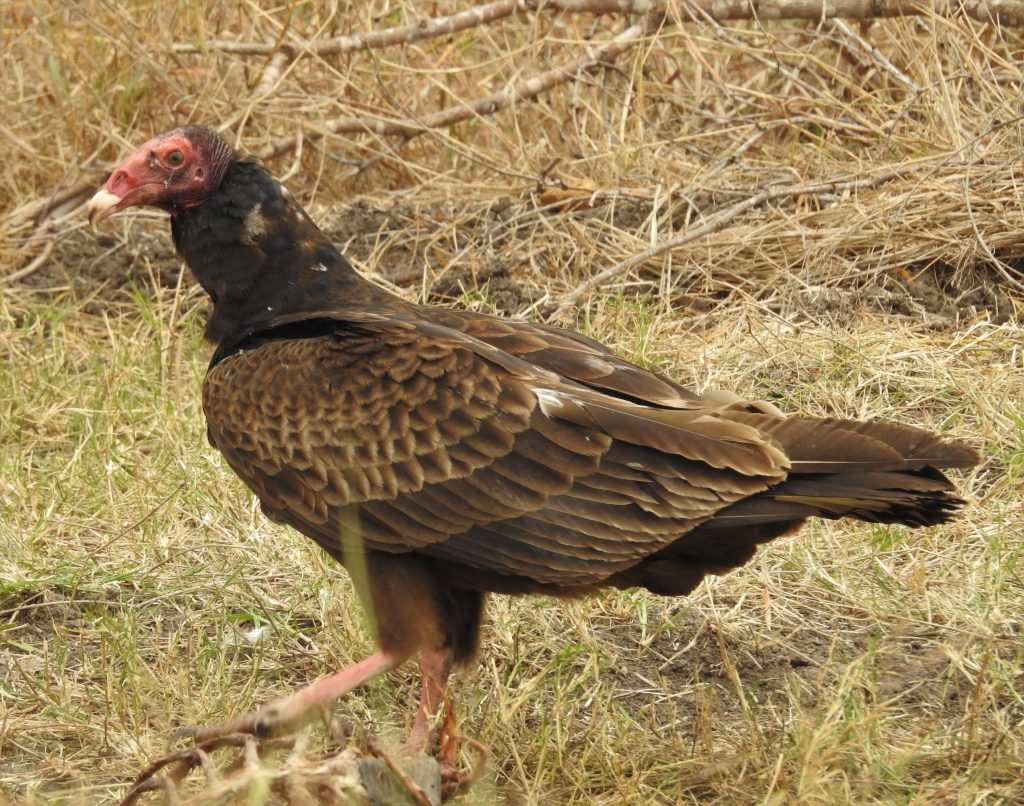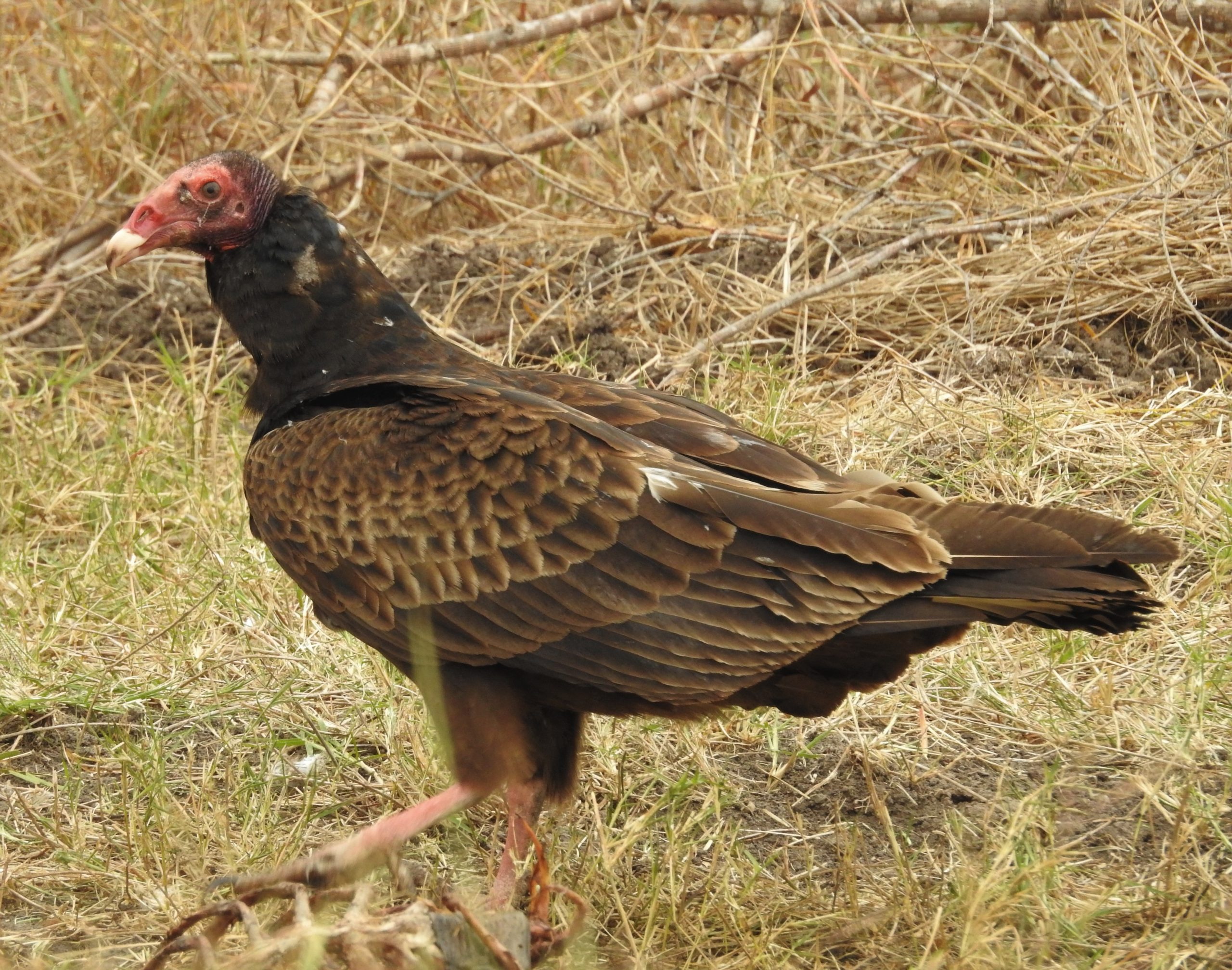by M. Kathy Raines

Hundreds of massive black shadows patterned the frond-strewn pathways at Sabal Palm Wildlife Sanctuary one winter’s midday. A loud crinkly crunch heralded their heavy plopping into dried sections of palms. Distinctive dark shapes, as graceful as ice dancers, wheeled above.
Each year, turkey vultures who opt to migrate from northern parts of the U.S. join our sizeable flocks, filling the skies, plummeting downwards—often joined by black vultures, crested caracaras or other raptors—to feed on dead creatures, leaving nothing but scattered bones. A vulture may gorge itself so much that it must partially digest its food before it ascends skyward.
Oddly, few of us celebrate vultures. While hawks, falcons and eagles reign as mascots, rare is the team dubbed “the Vultures”, despite the birds’ remarkable ability to scrub our world clean. Must a creature kill to earn respect—while we ourselves consume pre-butchered, dismembered chicken wrapped in plastic? Despite a vulture’s notable superpowers— a turkey vulture, outclassing other birds, reputedly catches a scent from a mile off— the Marvel universe employs it as a villain, and Looney Tunes, a clownish creature dubbed Beaky Buzzard.
The turkey vulture’s apt scientific name (Cathartes aura) means, in Latin, a “bird that purifies”, while the word “vulture” comes from Latin “vellere”, meaning “to tear or pluck”. While vultures in flight are called a “kettle” or “committee”, those feeding on dead creatures, form, suitably, a “wake”. With its bald head and wrinkled red neck reminiscent of a turkey’s, it can plunge headfirst into a carcass without requiring much cleanup. This vulture prefers fresh carrion, but it may await assistance from various mammals to open thick skin and initiate the feast. The turkey vulture’s dark brown plumage and silvery flight feathers, which, as it soars, give it a two-toned appearance, distinguish it from its co-resident, the black vulture. Juvenile turkey vultures pose a challenge to birders; they, like black vultures, also have black heads and beaks.
Unlike a hawk, a turkey vulture, with its long toes and blunted talons, exclusively employs its beak for tearing prey. With its acidic stomach and helpful microbiome, it nullifies toxins, viruses and bacteria in a rotting corpse that might sicken other animals. In fact, the vulture’s mouth is reputedly quite clean; one researcher, accidentally bitten by one—waylaid by her work, but frantic that the injury might fester— claimed the wound seemed to heal instantly. A vulture’s ability to resist infections from rotting corpses may hold promise for medical researchers.
Besides its acute sense of smell—it has one of the largest olfactory organs among birds—this vulture, with its keen sight, detects subtle changes—like grass recently mashed by a predator disemboweling a victim. In seconds, a turkey vulture can plummet thousands of feet to the ground.
At a feeding site, turkey vultures, hissing, grunting and occasionally biting, jostle among competitors—their fellows, smaller, but more aggressive black vultures, crested caracaras and various hawks—for primacy. When threatened or upset, the vulture may propel foul-smelling vomit or defecate on an opponent. (It may also defecate on its legs to cool itself off and kill bacteria).
Highly intelligent birds, turkey vultures have excelled at various feats, like the string-pulling test, wherein a researcher dangles meat from a 24-inch string fastened to a wooden platform. In one trial, six vultures set off to retrieve the meat. Three of them sucked up the string, apparently stashing it in their crops, then seized and ate the meat, expelling the string.
A pair of turkey vultures may sit together a few days or even weeks in mid-March or early May before laying eggs. Nesting sites include hollow logs, abandoned nests, vacant buildings or the ground, where they scrape out a space, pushing obstacles aside. Producing one brood a year, both birds incubate their two or three eggs and feed hatchlings regurgitated food.
As wind currents subside, usually a few hours before sunset, turkey vultures— sometimes in the hundreds, along with black vultures— roost in trees and various structures. Apparently activated by sunlight’s warmth, a vulture spreads its wings, its back to the sun, to dry dampened feathers and/or regulate its temperature. Then, it preens, folds its wings and, with slow, steady beats, prepares to fly into a rising thermal. Sweeping in circles within the column, it ascends to the skies, sailing with wings tilted in a slight V-shape, teetering slightly, and scans the ground for fresh prey.
Though vultures are generally disease-resistant, they are not immune to lead poisoning, which they sometimes acquire from eating animals that have been shot. Also, some vultures become sickened from pesticide-laced carcasses. Since a vulture looks downward as it flies, it sometimes crashes into wind turbines or collides with military aircraft.

